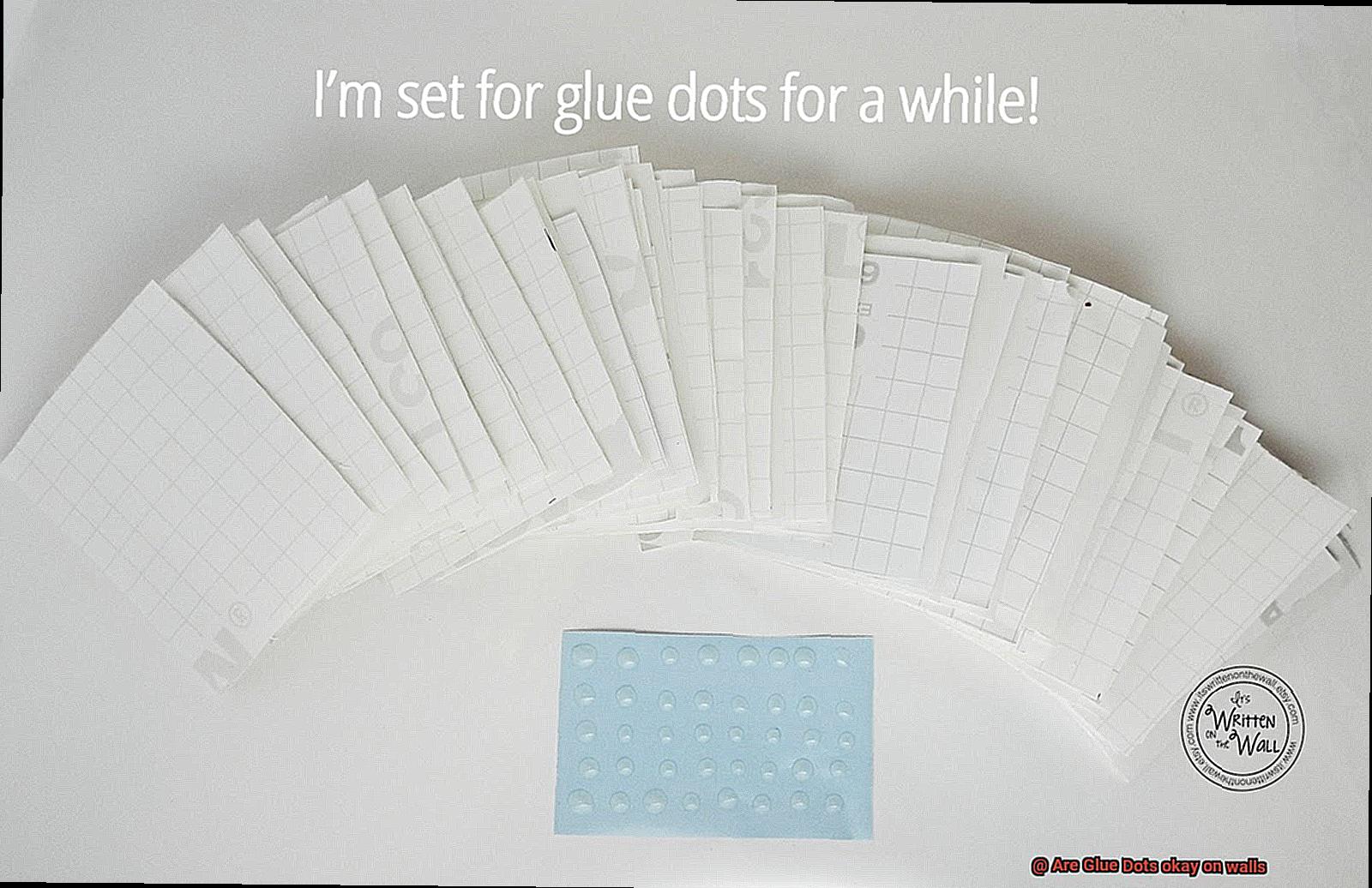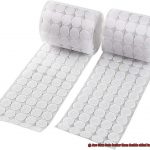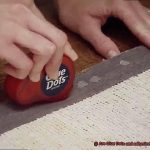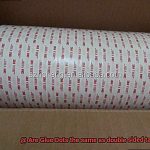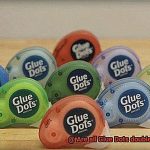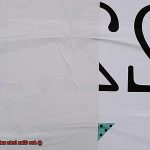Tired of ruining your walls with tape, nails, or screws? Desperate for an adhesive that won’t leave unwanted marks or residue on your surfaces? Then glue dots might be the solution you’ve been searching for. These small and versatile adhesives have become a popular choice for many people looking to simplify their DIY projects or home decor.
But what about using glue dots on walls? Are they safe to use? In this blog post, we’ll tackle the question “Are glue dots okay on walls?” We’ll explore the advantages and disadvantages of using glue dots on walls, discuss which surfaces work best with them, and offer tips for using them effectively.
Not only that, but we’ll also address common concerns like whether glue dots leave behind any traces on walls, how to remove them from walls without causing damage, and how long they last. So whether you’re a crafting fanatic or just someone who wants to hang up pictures without destroying your walls, this post will provide all the information you need to make an informed decision about using glue dots on your walls.
What are Glue Dots?
Contents
- 1 What are Glue Dots?
- 2 What Surfaces Can Glue Dots be Used On?
- 3 Should You Test a Small Area Before Applying Glue Dots?
- 4 What Happens if You Use Glue Dots on Wallpaper?
- 5 What Happens if You Use Glue Dots on Painted Walls?
- 6 How Much Weight Can Glue Dots Hold?
- 7 Are There Alternatives to Using Glue Dots on Walls?
- 8 Conclusion
As DIY enthusiasts, we all know the pain of finding the perfect adhesive that won’t cause damage to our walls or leave a mess behind. Say hello to Glue Dots – the ultimate adhesive solution that is versatile, easy to use, and mess-free.
Glue Dots are small, circular adhesive dots that come in a variety of sizes, strengths, and colors. They are a fantastic alternative to traditional liquid adhesives like glue or tape and can be used for a wide range of applications. Here’s why Glue Dots are a must-have for every DIY enthusiast:
- Mess-free and easy to clean up: Unlike liquid adhesives, Glue Dots don’t leave any residue or cause any damage when removed. You can easily peel them off surfaces without any mess, making them perfect for any project.
- Versatile: From paper to walls and other materials, there’s a Glue Dot for every need. They come in different sizes and strengths, depending on the weight of the item you want to stick.
- Temporary solution: Perfect for those who want an adhesive solution for their projects that won’t cause permanent damage. Glue Dots can be removed easily without leaving any traces behind.
- Easy to use: Using Glue Dots couldn’t be easier. Simply peel off the dot from the sheet and apply it to the surface you want to stick. No drying time required.
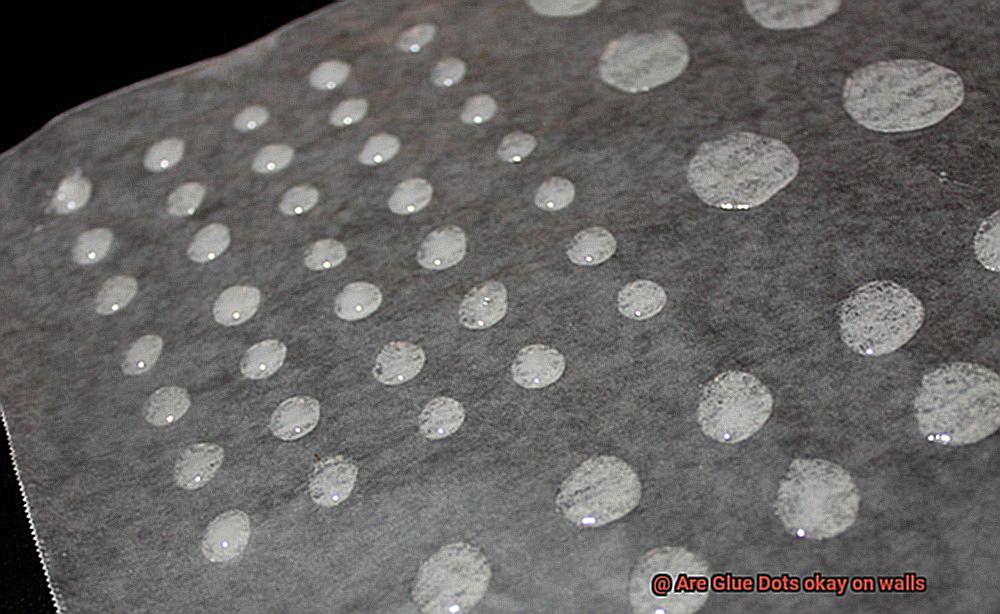
However, when it comes to using Glue Dots on walls, it’s crucial to test a small area first to ensure they don’t cause any damage. Heavier items may require stronger adhesives or different mounting methods altogether.
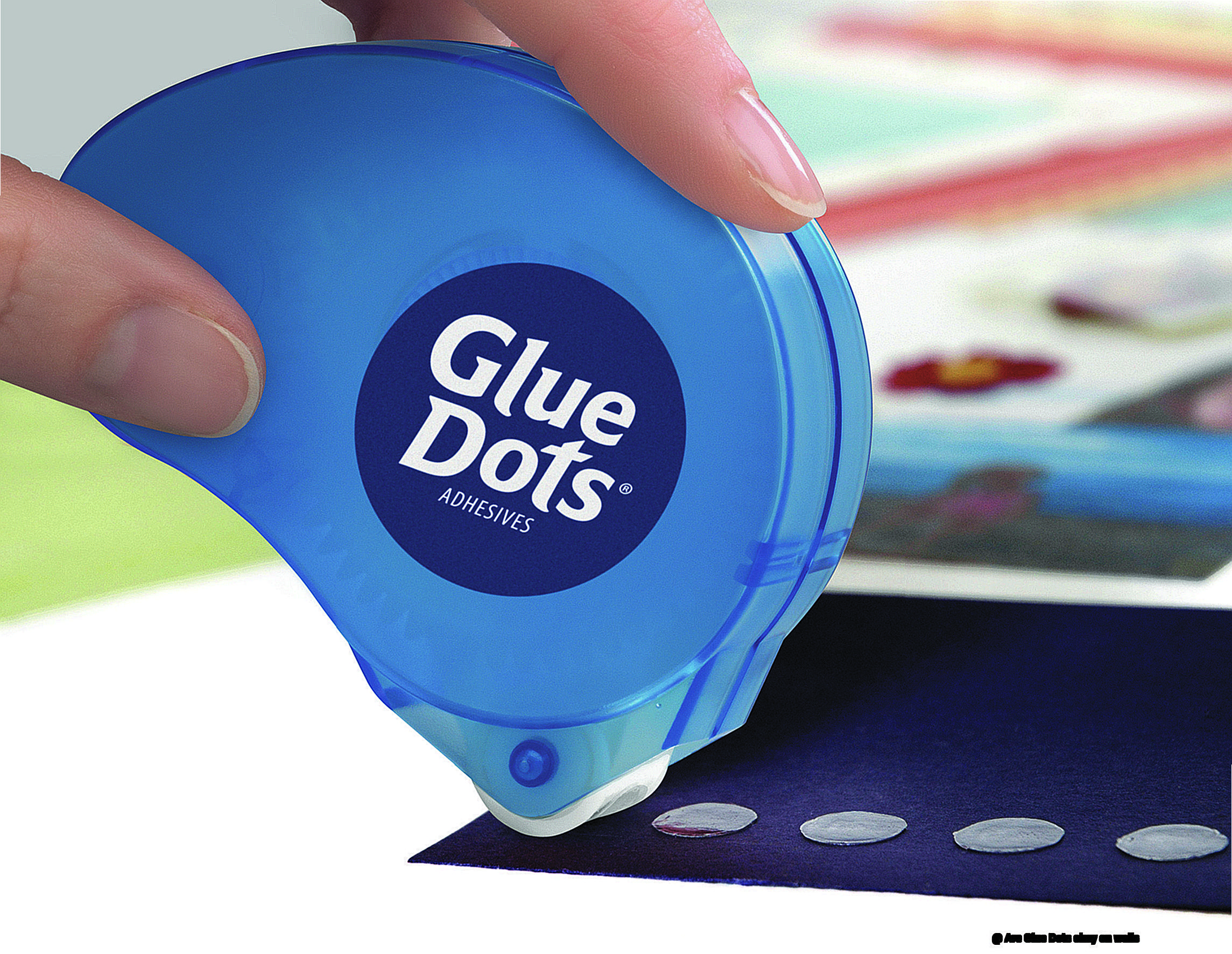
What Surfaces Can Glue Dots be Used On?
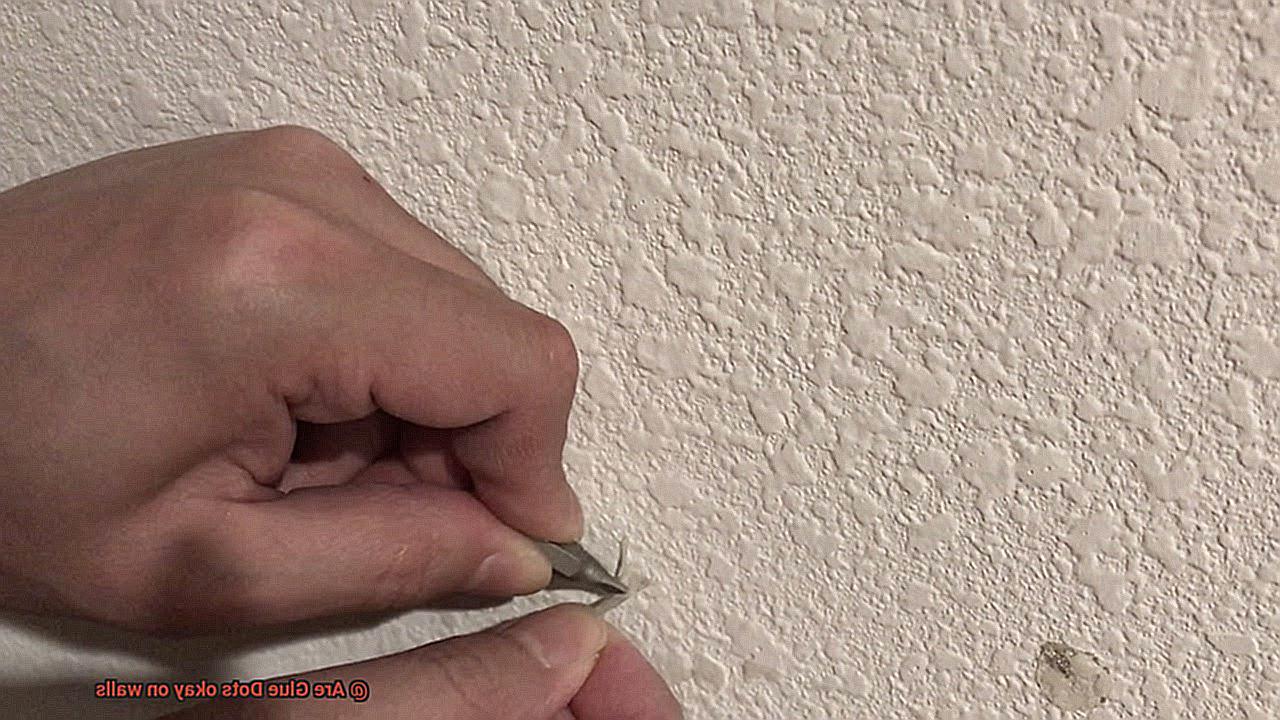
If you’re looking for a versatile adhesive solution for your next project, look no further than glue dots. These tiny dots pack a powerful hold and can be used on a wide variety of surfaces, including paper, cardboard, plastic, metal, fabric, and even wood. Whether you’re working on crafts, home decor, or office projects, glue dots are the perfect solution.
One of the biggest advantages of glue dots is that they don’t leave any residue or damage behind. This makes them an ideal choice for temporary or semi-permanent applications where traditional adhesives may not be suitable. Plus, they’re incredibly easy to use – simply peel and stick.
But what about using glue dots on walls? Can they be used on any surface? Well, it depends. Glue dots work best on smooth and non-porous surfaces like painted walls, wallpaper, glass, and tiles. However, if your wall surface is textured or porous (like brick, concrete, or stucco), glue dots may not work as well.
To ensure the best results, it’s recommended that you test a small area first before applying glue dots on a larger scale. This will help you determine if the glue dots will stick properly and if they can be removed without causing any damage.
Overall, glue dots are an excellent choice for temporary wall decorations or hanging lightweight items like posters or photos. They offer a strong hold without leaving any damage or residue behind. So go ahead and unleash your creativity with glue dots – the possibilities are endless.

In summary, here are some key takeaways about using glue dots on various surfaces:
Should You Test a Small Area Before Applying Glue Dots?
Let’s explore the reasons why this step is crucial.
Firstly, testing a small area ensures that the glue dot will hold securely without damaging the wall or leaving residue behind. It’s essential to know how well the glue dot will adhere to the wall before committing to sticking your item on it. By testing a small area, you can avoid causing any unwanted damage to the surface of your wall.
Secondly, testing a small area is particularly crucial when working with delicate or valuable items. These items require extra care and attention, and using the wrong adhesive could result in damage and costly repairs. By testing a small area first, you can ensure that your precious items will remain unharmed and held securely in place.
Thirdly, some types of glue dots may leave a residue behind or be visible, which can negatively impact the appearance of your wall or item. By testing a small area first, you can determine whether the glue dot will leave any marks or be visible once your item is hung.
To test a small area, follow these simple steps: apply a single glue dot to the wall and press it firmly in place. Wait for several hours or overnight to see if the glue dot holds securely and does not damage the surface of the wall. If everything looks good, then you can proceed with sticking your item on the wall using glue dots.
What Happens if You Use Glue Dots on Wallpaper?
Decorating your home is one of the most exciting parts of moving into a new place or giving your old one a facelift. But before you reach for those trusty glue dots, you should know what happens when you use them on wallpaper. As an expert on this topic, I can tell you that it’s best to approach this adhesive with caution.
One of the main issues with using glue dots on wallpaper is that they can leave behind an unsightly residue. Removing this residue can be difficult, particularly if you have textured wallpaper. Even worse, attempting to remove it could damage the wallpaper itself. If you want to avoid spending hours scrubbing at your walls with a chemical cleaner, steer clear of glue dots.
Another problem with glue dots is their weight limit. While they work wonders for lightweight items like posters and photos, heavier objects like mirrors or shelves can cause them to lose their grip and fall off the wall over time. This weight can also cause your wallpaper to peel or tear.
Before committing to glue dots, here are some tips to consider:
- Test a small area first: If you must use glue dots on your wallpaper, test them out in a small area first to see how they hold up.
- Avoid heavy items: Stick to lightweight items when using glue dots on wallpaper.
- Explore alternative options: Consider using removable wall hooks or picture hangers designed for use with wallpaper.
If you’re renting a space with wallpaper, be extra careful. Damaging the wallpaper could result in losing your security deposit.
What Happens if You Use Glue Dots on Painted Walls?
As a DIY expert, I’m here to share some important information about what happens when you use glue dots on painted walls.
Firstly, using glue dots on painted walls can pose a significant risk of damaging the paint. The adhesive in the dots can become stronger and harder to remove as time goes by, leading to peeling or chipping paint when you try to remove them. This is especially true for freshly painted walls, where the glue dots may not adhere properly and could fall off after a short period of time.
But that’s not all. Even if the paint isn’t damaged during removal, using glue dots on painted walls can leave behind unsightly residue or marks. The adhesive from the dots can cling to the wall causing discoloration or marks that can be particularly noticeable in well-lit areas or lighter-colored walls.
Fortunately, there are alternative options designed specifically for hanging things on painted walls, such as removable wall hooks or picture hangers. These products are created to hold up heavier items without damaging the paint or leaving any residue behind.
How Much Weight Can Glue Dots Hold?
Glue dots come in different sizes and thicknesses, which determine their weight capacity. The larger and thicker the glue dot, the more weight it can hold. For instance, a standard 1/2 inch glue dot can hold up to 1 pound, while a thicker 1-inch glue dot can hold up to 2 pounds. It’s essential to choose the right size for the item you want to hang.
Moreover, the surface you apply the glue dots onto plays a crucial role in their weight capacity. Glue dots work best on smooth and clean surfaces like painted walls, glass, and metal. Textured or porous surfaces like brick or concrete may not provide enough adhesion for the glue dots to hold securely.

When using glue dots on walls, evenly distributing the weight of your item across multiple glue dots is vital. This will help distribute the weight more evenly and prevent any one glue dot from bearing too much weight. It’s better to use additional glue dots than rely on just one.
Are There Alternatives to Using Glue Dots on Walls?
There are numerous alternatives available to suit your needs. As an expert on this topic, I have researched and put together some great options for you.
Firstly, removable adhesive strips like the popular Command Strips are a perfect alternative. These strips are specially designed for wall use and can hold more weight than glue dots. Additionally, they are easy to remove without causing any damage to the wall surface.
Another option is using suction cups or hooks. Suction cups or hooks are ideal for hanging lightweight items like decorations or picture frames. However, it’s crucial to make sure that they are specifically designed for wall use and installed correctly to avoid any damage.
If you prefer non-adhesive methods of wall decoration, you could try using picture ledges or shelves to display items. This is a perfect way to avoid hanging anything directly on the wall. Alternatively, leaning artwork against the wall can also work well for a more relaxed look.
Conclusion
To wrap it up, glue dots are a versatile and user-friendly adhesive that can be used for various purposes, including temporary wall decorations and hanging lightweight objects. However, before applying them to your walls, it’s essential to conduct a small test to ensure they won’t leave any residue or cause damage.
Glue dots work best on smooth and non-porous surfaces like painted walls, wallpaper, glass, and tiles. They can support a considerable amount of weight depending on their size and thickness but may not be the right choice for heavier items or textured surfaces.
If you’re searching for alternatives to using glue dots on walls, removable adhesive strips like Command Strips or suction cups/hooks are excellent options. Picture ledges or shelves are also perfect for displaying items without hanging anything directly on the wall.
In conclusion, regardless of whether you’re an avid crafter or someone who wants to adorn their walls with pictures without causing any harm, there is an adhesive solution that will meet your needs.

